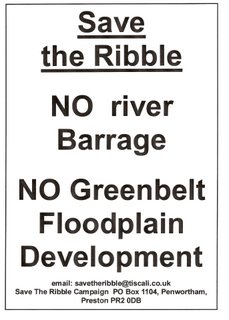Guide to Local Development Framework Consultation: Have YOUR Say, Now!
This public consultation is so that YOU can tell the policy makers at Preston City, South Ribble Borough, and Chorley Borough Councils what kinds of developments you would and would not like to see in YOUR area up to 2021…
Whilst there is a confusing number of documents available on the LDF consultation website, you only need to look at the Core Strategy Issues & Options Paper ("CSIOP" which is Document 2 on the downloads link) to be able to complete the Response Form (Document 1).
Questions you are being asked in the Local Development Framework Consultation include:
-Whether we should protect and improve our environmental assets (Response Form [Document 1] Question 32);
-What level of protection should be given to sites of local biodiversity and geological importance (Issue 5A);
-Whether development should be allowed on Green Belt areas (Issues 1B, 1C, and 2D);
-Whether some areas of land should be removed from the Green Belt for development (Issue 1C);
-Whether development should be allowed in areas at risk of flooding (Issue 5F);
-Whether new crossings should be built over the Ribble – an option directly linked to the Riverworks barrage as the preferred option is a barrage with a road over the top – (Issue 4C; & see Core Strategy Sustainability Appraisal ["SA" Document 3] pages 24 to 25 for issues of environmental impact of a bridge only - without a barrage;
and see point 1 below for the stated aims of a barrage & road in one, which of course would have an enormous environmental impact even though this is not highlighted in the Core Strategy Sustainability Appraisal ("SA" Doc 3);
-What sustainable transport policies we would like to see (Response Form Doc 1, Issues 4A, B & C);
!! And the LDF consultation includes mention of and even unsubstantiated claims about Riverworks – both overtly (see p10, and p46 point 5.15 in the Core Strategy Issues and Options Paper ("CSIOP" Doc 2)), and somewhat hidden from obvious view - see discussion below regarding Flooding: Issue 5F, Option C, see p35 in the Core Strategy Sustainability Appraisal ("SA" Doc 3).
… and also ...
...several of the other documents available through the LDF website downloads link discuss the Riverworks scheme as something to be pursued as part of Preston's "Vision" and as part of the Local Development Framework process, including that:
1. 'Preston City Council is currently assessing the feasability of a barrage across the River Ribble, which could incorporate a new road crossing' (p24-25 in Doc 5: "Sub-Regional Strategy (SRS)");
2. That they see a need to a 'review of green belt boundaries south of the River Ribble through the Local Development Framework' (pages 17 and 19 "SRS" Doc 5)
-that is, to REMOVE these areas from Green Belt designation to enable built developments here;
3. Amongst the "strengths" identified in the 'drive' for 'Regeneration' in this same document is the 'close proximity to environmental assets of national significance' (p12 "SRS" Doc 5)
- er... but only if you don't wreck these by building a barrage and massive housing and business developments on them!!
4. Amongst the 'weaknesses' which pose a threat to the realisation of this "Vision" are:
- the 'green belt designation between the urban areas of Preston and South Ribble, South of the River Ribble' (p12 "SRS" Doc 5)
(hence the need to remove this protection (pages 17 and 19 as mentioned for point 2 above)
- and 'environmental constraints, particularly from flooding, constraining development opportunities' (p13)...
Clearly, the Local Development Framework process is being used to pursue the Riverworks Project, mentioned in most of the Documents - 2, 3, 5, 6, 7, and 8 - with only document 4, the Sustainability Appraisal Scoping Report, concentrating on the environmental significance of the Ribble and Green Belt areas, and the other environmental treasures of the area…
The LDF Public Consultation is taking place in two ways:
**Public Drop-In sessions -
Chorley: Tuesday 6th March, Committee Room 1, Town Hall ANYTIME between 4 - 7pm;
South Ribble: Tuesday 13th March in United Reform Church Hall, Hough Lane,
Leyland ANYTIME between 4 – 7pm;
Preston: Wednesday 21st March in Meeting Room A, Town Hall, Preston ANYTIME between 4 – 7pm.
**By filling in a Response Form - to be completed by 30th March 2007 – so don’t delay, DO YOURS TODAY!
Yes, it IS rather a long and complicated affair, and yes, you DO really need to at least read the questions on the Core Strategy and Issues Options Paper ("CSIOP" Document 2) and use this to complete the Response Form, but this is YOUR chance to have YOUR say, and it can be done relatively painlessly on-line, or you can phone them to ask for a hardcopy...
– and pop along to one of the Drop-In Sessions to have your say there too!
**If you are a member of an interest group – including environmental groups – you can also register to attend either of the two Stakeholder’s Workshops being held so far:
Tues 13th March, Meeting Room A, Town Hall, Preston, 2-4pm;
Monday 19th March, Lancashire Football Association HQ, Thurston Road, Leyland, 2-4pm.
CONTACT consultation@centrallancscity.org.uk or telephone 625384 to register, or order hardcopies of forms, or if you have any queries about any part of the consultation process....
Save The Ribble Campaign are highlighting in particular the points mentioned above, as detailed here, followed by the other issues in the LDF:
Theme 1 : Locating New Development.
The greatest concerns for Save The Ribble here are protecting our valuable Green Belt from development.
1B: we chose answer B as of course local needs must be met in rural areas but not by developing on Green Belt;
For 1C: we chose answer E “somewhere else” as development on Green Belt land should be avoided. Green Belt land should be safeguarded for local people and our environment now, and for our future sustainability.
Issue 5: Protecting the Environment.
We agreed with the Core Strategy as protecting the environment must be a priority.
Obviously we should be protecting ALL sites of local biodiversity or geological importance from development – as well as sites on National and International ecological importance!
We also feel that we should protect our landscapes based on their intrinsic value, and their biodiversity and environmental significance, not just for the potential recreational or agricultural value for people.
Small-scale renewable energy schemes should be mandatory on all new developments regardless of size, and should be the focus of priority development on all existing buildings, both residential and business, with encouragement and grants from Local Authorities.
**THIS NEXT ISSUE IS OF SERIOUS CONCERN!!**
Issue 5F: Avoiding Flooding…
It’s obvious to everyone, not least the Environment Agency, that we must avoid any new development in areas at risk of flooding…
but we are also very concerned that Option C on flooding issues bears only a general resemblance to the issue as it is raised on p35 of the Core Strategy Sustainability Appraisal ("SA" Doc 3) for this option, which specifically discusses Riverworks, and makes unsubstantiated claims that this project:
- ‘may have a significant positive impact on environmental criteria by virtue of improved management to river flooding’,
and that
- ‘the risk from river flooding would be reduced’,
also that
- ‘the scheme would have a significant positive impact as it promotes the development of land, which has previously been unsuitable’.
Clearly all of this claims are unsubstantiated, and we have highlighted our concerns about these suppositions on several levels, not least that the evidence suggests that our flood risk could actually be increased and that this so-called 'unsuitable' land is actually our valuable Green Belt and Floodplain!!
We argue that:
a) There has been no hydrological, geological, or Environmental Impact Assessment for this project to ascertain whether flood risk would be decreased or increased, although a “River Ribble Weir Appraisal” commissioned by Preston and South Ribble Councils by Halcrow and Partners c.1986 highlights that the floodrisk from high river flows on the Ribble may actually be exacerbated by such structures, and consequently such structures would need to remain open during high rainfall periods, both winter and summer. Their report identifies no potential protection from flooding of such a structure;
b) The Ribble Shoreline Management Plan does not indicate the need for a tidal barrage to protect Preston or South Ribble from flooding, indeed the SMP concludes that the existing natural and artificial defences are adequate, and where flood defences need to be strengthened in the future, the stated aims and objectives for the SMP, DEFRA, and the EA is to create further natural flood defences (mudflats and saltmarsh), plus reinforcing existing artificial banks when necessary, as the only economically and environmentally sustainable options;
c) This ‘unsuitable land’ is designated Green Belt, includes football pitches, allotments, a Local Nature Reserve, Biological Heritage Sites and Priority Biodiversity Action Plan Habitats, agricultural land, and valuable countryside areas which offer easily-accessible and high value green amenities to local people.
It would also continue to be a floodplain as it is the river’s floodplain, not the sea’s floodplain!
d) As the LDF is a development strategy looking at planning issues and themes for development in general terms and regarding development principles, why is a specific project and its unsubstantiated claims being considered here?
e) Would responses choosing Option C unknowingly be choosing the Riverworks option? As the Sustainability Appraisal (Doc 3) was not sent out with the Core Strategy Issue & Options Paper, is only available online, and is only one of several documents, most people may not even read it.
The whole section about Option C for Issue 5F on the Core Strategy Sustainability Appraisal ("SA" Document 3) reads as follows:
‘Option (c): Promote major schemes such as Riverworks to manage river flooding to such an extent that otherwise unsuitable land could be made available for development.
Riverworks is a major scheme and although it may have a significant positive impact on environmental criteria by virtue of improved management to river flooding, there are other considerations to take into account, such as the impact of the works on the biodiversity resource, the landscape character and green belt. This option is closely linked to Issue 4C Option g) concerning a new river crossing across the River Ribble. It is unclear whether the land in question is identified as previously developed, but where it is, this would have a significant positive effect upon environmental criteria. There would be a minor positive impact on social criteria because the risk from river flooding would be reduced. In respect of economic criteria, the scheme would have a significant positive impact as it promotes the development of land, which has previously been unsuitable.’ ("SA" Doc 3, p35).
Clearly these are seriously unsubstantiated and potentially disastrous assumptions which cannot be left unchallenged!
As far as the rest of the consultation goes, we argue that our quality of life is also very important, and is intimately related to our concerns about the threats posed to our environment, and to what appears to be a fairly minimal focus in the LDF on actively improving the lives and local environments of all of our citizens, for now, and in the long term.
Theme 2 issues: Meeting Housing Needs.
Our comments for this section were questions about how affordable housing can be safe-guarded to ensure that affordable both MEANS and REMAINS affordable as there are no suggestions being made for how the problem of “market forces” can be addressed. The need for affordable housing is a long-term issue and needs a sustainable answer as the current situation means that so-called affordable housing continues to escalate in price along with other housing, ensuring a continued need to build more and more and more “affordable” housing to meet demand, and putting more and more pressure on land for development…
… which leads us particularly to Issue 2D, for which we chose Option A, as we must always consider Previously Developed Land first.
Theme 3 issues: Fulfilling Economic Growth.
An interesting issue, and one which seems to form the central Core Strategy in all the stated aims and policies in the LDF, despite the fact that the LDF documentation itself recognises that this area of Lancashire in particular ‘is identified as a result of its strong economic performance, particularly in recent times’ (p8 CSIOP Doc 2)…
So...
- if the economic performance for this area is already strong…;
- if the current rate of development is showing the strain of our unsustainable forms of development (in both global and local terms, from climate change and unsustainable carbon and other greenhouse gas emissions, to traffic congestion, pressures on our local environment and our quality of life;
- and yet we still have some of the worst pockets of deprivation in the country, particularly in Preston (p19 CSIOP Doc 2)…;
- and if it is now clear that we all need to reduce our unsustainable environmental impact…;
-WHY IS THE CENTRAL FOCUS OF THE LDF AN INCREASE IN ECONOMIC GROWTH IN THE USUAL TERMS?
The LDF should have been a real opportunity to try to identify how we can reduce our environmental impact at the same time as directly tackling deprivation and the decline in our local community amenities and services, not least in our traditional town and village centres as well as our urban areas…
As such, our concerns in this section had a focus on:
- local development which identifies and addresses local needs, but does not include further developments alongside the motorways as this impacts on the Green Belt;
- that developments in tourism should be sustainable eco-tourism which aims to have the lowest possible impact on the environment;
- that leisure resources for local people, our green spaces and amenities should be protected from development to ensure this valuable resource remains accessible to all.
Theme 4 Issues: Improving Accessibility.
Several of the options raised are certainly useful ways forward, but we felt that the idea of accessibility should have greater emphasis on – and greater investment in - public transport, and safer walking and cycling networks, rather than car use, and there is also the desirability of encouraging more working from home, and greater use of internet conferencing etc, to reduce the need to travel...
Issue 4B does identify a good list of sustainable transport ideas… but there really needs to be positive investment in public transport and walking/cycling facilities to present these as truly viable options for everyone. Road charges would be less of an issue if people had a genuine choice…
For Issue 4C: we chose answer J, the combination measures but commented "except absolutely NO to Option G, a new crossing over the River Ribble, as this would cause unacceptable damage to the environment, both the River itself and the local green belt".
- Nor should the motorway networks be increased (no to H), nor create more direct road links to the airports as we need to also reduce the growth in flying (no to I).
- We welcomed Option F in these comments as the provision of an integrated network of cycle and walking routes, alongside real investment in Public Transport, is essential.
There are real issues to be addressed in both our rural and urban communities, and these should be addressed at the same time as we consider the urgent necessity of protecting our environment in local, national and global terms.
Current levels of growth are proving to be unsustainable in terms of environmental impact (both global warming and local environmental depletion, traffic congestion etc), and for the economic life of deprived areas of the community.
As this area of Lancashire already has strong growth, the emphasis needs to be on actively reducing our environmental impact (actively reducing our carbon footprint and local environmental impact), whilst actively seeking to tackle the real deprivation that exists in some of our communities as the “trickle-down” effect does not work.
An alternative and positive Strategy would benefit existing and future communities, as well as our economic and environmental sustainability in the long-term (see the Stern Report).
Have YOUR SAY about these development proposals for YOUR AREA...
GO TO ONE OF THE DROP-IN SESSIONS;
TRY TO MAKE TIME TO COMPLETE THE RESPONSE FORM, by 30th March!
You can find all forms and contact details and an on-line form at www.centrallancscity.org.uk
You can contact us at savetheribble@tiscali.co.uk















0 Comments:
Post a Comment
<< Home